Summertime brings with it the joys of fresh produce, fun outdoors, and gardens in bloom. Unfortunately, it also brings pesky houseflies buzzing about, indoors and out. But you can take advantage of those joyful summer vibes to grow effective plants that repel flies!
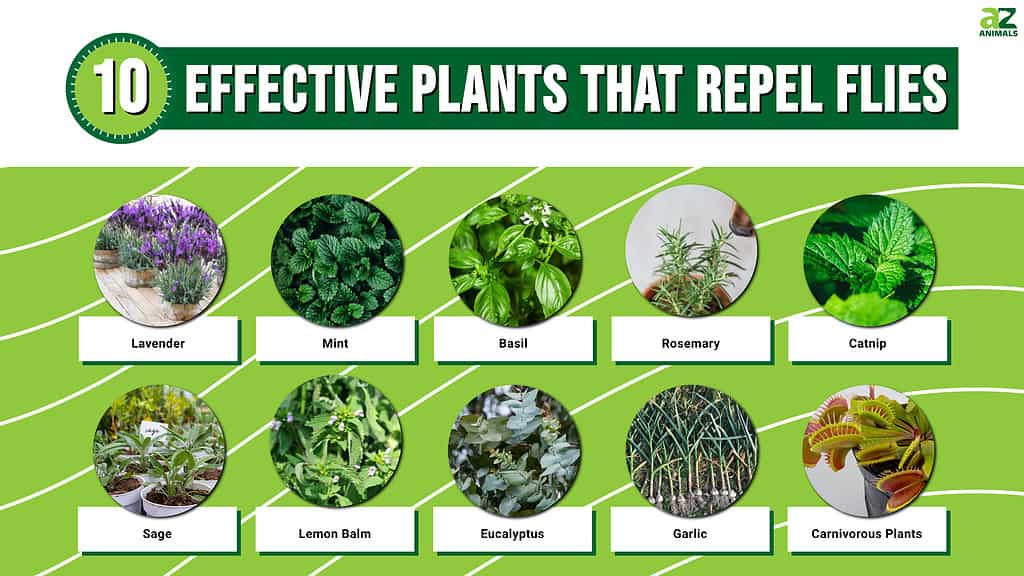
Keep reading to discover 10 easy-to-grow plants that flies won’t want to get anywhere near. In addition to repelling flies and other insects, these plants add beauty to pots on the porch and in your home.
Important Note: Some fly-repelling plants are toxic for pets, so check for that warning in each plant description below.
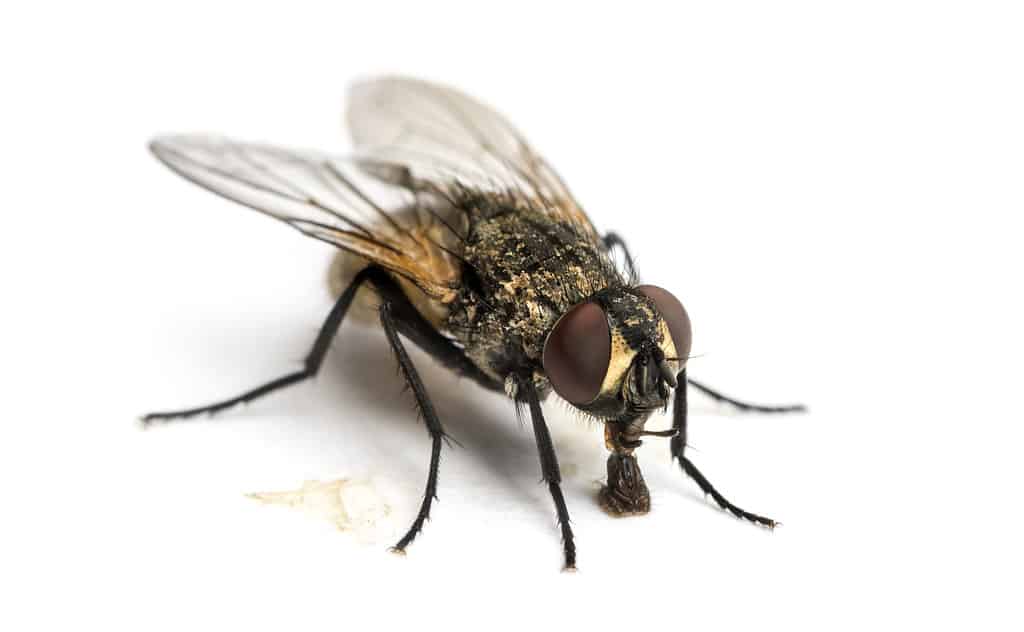
Plants that repel houseflies usually produce an aroma that flies can’t stand.
©Eric Isselee/Shutterstock.com
How do plants repel flies and other insects?
Before we discover some great fly-repelling plants, let’s explore why they work at making certain bugs disappear. Or, more specifically, how plant oils cause some arthropods (including flies, fleas, mosquitoes, and more) to turn away.
Certain plants, like herbs, work as natural repellents against flies mainly because of their aromatic oils that flies don’t like. For example, flies love the smell of the natural oils on human skin, but they do not love the smell of the linalool oil responsible for a lavender plant’s scent. This fact is why skin care companies add essential oils like lavender to bug-repellent sprays and creams.
So your goal is to create a plant paradise full of amazing smells you love, but flies don’t.
Speaking of lavender, it’s one of the best fly-repellent plants of them all. Read on to learn about this and more plants to grow as natural bug repellents in and around your home.
1. Lavender
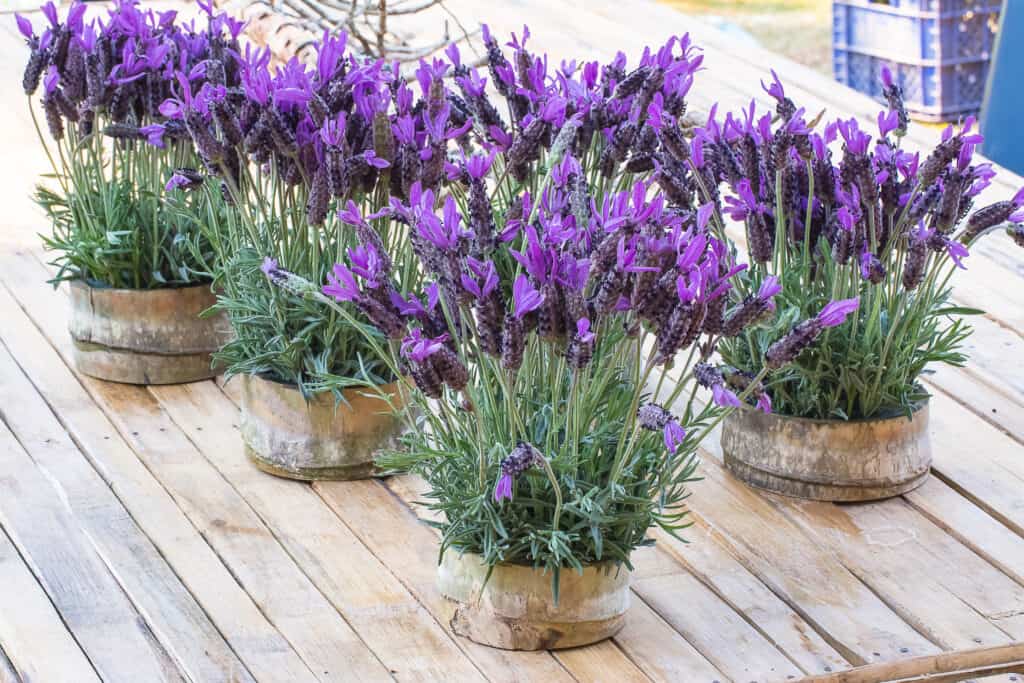
Grow lavender plants indoors and out to repel flies.
©Shan 16899/Shutterstock.com
If you love the smell and look of lavender plants, this is your lucky day. Because scattering potted lavender around your home can help keep the annoying flies at bay.
Two big reasons that flies hate to be around lavender are the natural oils it produces called linalool and geraniol.
A 2008 study showed that linalool and geraniol are more effective at repelling flies than citronella oil. The study results show that candles made with 5% citronella had a sand fly repellency rate of 24.7%. However, candles made with 5% linalool oil from lavender had a sand fly repellency rate of 55.2%. Even better, candles crafted with 5% geraniol oil had a sand fly repellency rate of 79.7%!
So it’s clear that lavender plants contain valuable fly-repelling compounds. Plus, they add a lot of charm and a lovely scent to wherever you display them.
If you’re hoping your lavender plants will also repel bees, they won’t. Bumblebees and honeybees are very attracted to lavender and help pollinate the plants. So repel flies while also supporting the survival of bees by filling your sunny deck or porch with pots of lavender.
Is lavender toxic for pets?
The linalool oil in lavender plants is toxic for dogs and cats. Though your pets would probably need to consume a lot of lavender to get very sick, it’s best to keep these plants safely out of their reach.
2. Mint
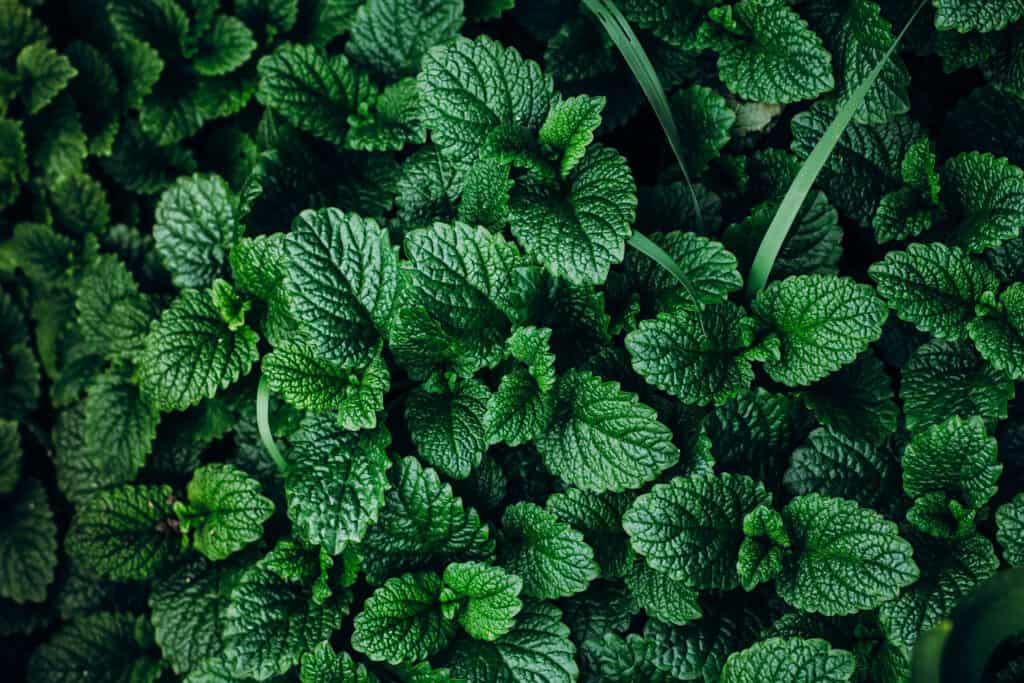
Many plants in the mint family are effective at repelling flies.
©AnikonaAnn/Shutterstock.com
Growing mint is a great way to repel flies from your house, garden shed, and rooms with sufficient sunlight. Fortunately, in addition to having a strong scent that flies loathe, many other pests hate mint too. For example, ants, moths, and even mice don’t like the smell of mint.
In particular, peppermint and spearmint plants are great for repelling houseflies and other pests. And a fun fact about peppermint is that it’s a hybrid plant created from crossing spearmint with watermint. Plus, the aquatic watermint is an excellent plant choice for repelling flies (while attracting butterflies) around the water features in your yard.
Mint is very easy to grow, but be aware that it can take over a garden bed pretty quickly. That’s great news for repelling flies in plots next to your home, but your nearby plants could suffer when this aggressive plant takes over. However, growing more mint could also mean enjoying more fresh mint smoothies and tea while the flies disappear.
Is mint toxic for pets?
Cats and dogs should never eat mint. The oils in mint plants can cause diarrhea and vomiting in dogs, cats, and horses if consumed in large quantities. Furthermore, be aware that the oils from the English pennyroyal mint plant (Mentha pulegium) are highly toxic to pets and humans in any quantity.
3. Basil
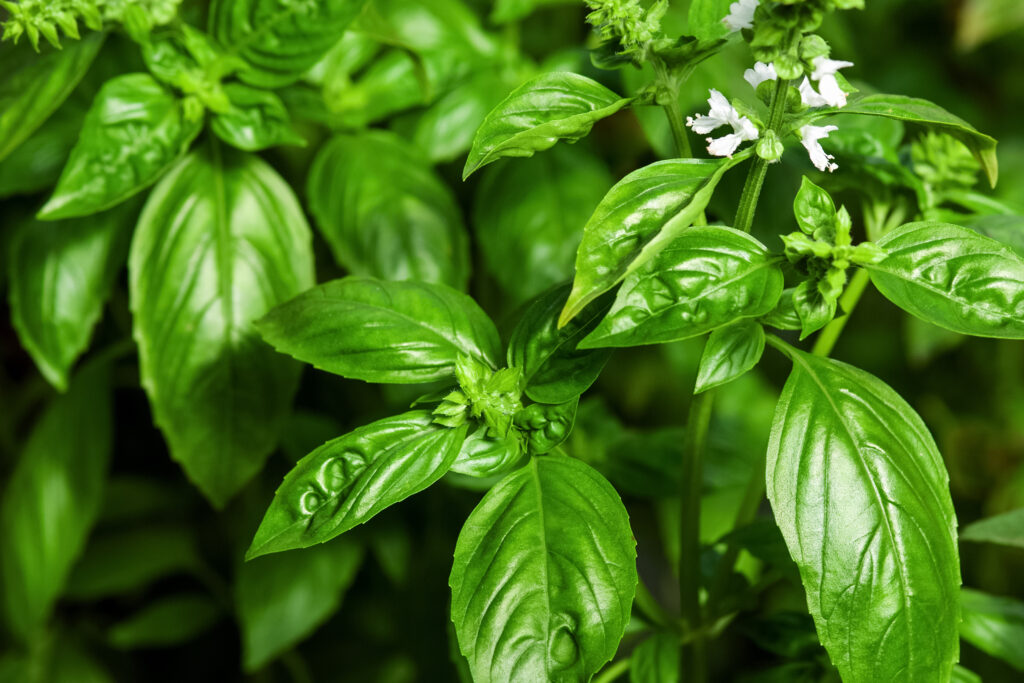
Linalool is a compound in basil that repels flies.
©Nadya So/Shutterstock.com
Like lavender, basil is a source of aroma compounds like linalool that repel flies. And basil is also a delicious culinary herb used in cooking. So this is one of many fly-repelling plants with multiple benefits, in addition to repelling mosquitos too.
Did you know that there are 12 types of basil? The strong scent of most basil varieties makes these plants perfect for repelling flies in larger rooms plus around windows and doorways.
Basil also produces flowers that attract pollinators like bees and butterflies.
Is basil toxic for pets?
The ASPCA states that basil is not toxic for cats or dogs. So feel confident growing fly-repelling basil plants without worrying about poisoning your beloved pets.
4. Rosemary

Potted rosemary plants around the house help keep the flies away.
©Switlana Sonyashna/Shutterstock.com
The fragrant culinary herb rosemary is another member of the mint family. And it’s another plant that smells wonderful to you but awful to flies. Like other mint-family plants, rosemary also contains linalool and other aromatic compounds that flies detest.
In addition to adding potted rosemary plants to your decor, you could snip some sprigs to place in bowls on your counters and dining room table. The aromatic oils from the rosemary sprigs will last a long time and help move those irritating flies out of your way.
Is rosemary toxic for pets?
Rosemary is safe for dogs and cats to eat in small quantities.
5. Catnip
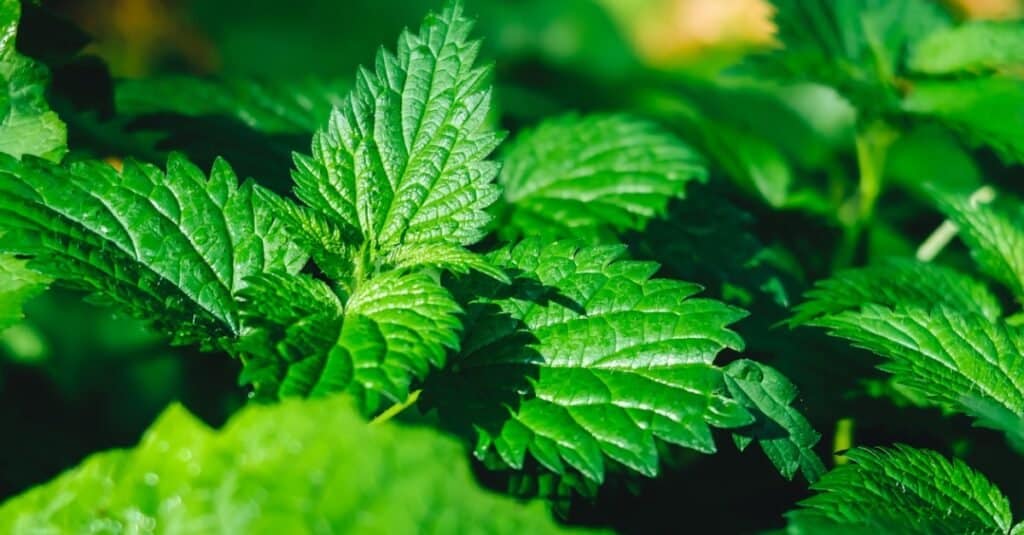
The catnip plant is a powerful insect repellent for flies, mosquitos, and roaches.
©Attila Fedyk/Shutterstock.com
Catnip (also in the mint family) is a powerful repellent for flies and other insects like mosquitos and roaches. In fact, this herb is said to be nearly as powerful as using products with the strong pest-repelling chemical called DEET!
However, the best way for catnip plants to work as natural pest repellents is to cut into or smash a few of their leaves. This action releases the fly-repelling chemicals in catnip called iridoids. But if you have a cat, your catnip-loving feline will do that iridoid-releasing work for you by chewing the leaves on the plant.
Is catnip toxic for pets?
We already know that catnip is a favorite treat for cats, but you might wonder if it’s safe for dogs too. Fortunately, the answer is yes – catnip is safe for dogs and other pets. However, ingesting too much catnip can cause an upset stomach for both animals, so consider letting your pets enjoy this herb in moderation.
6. Sage
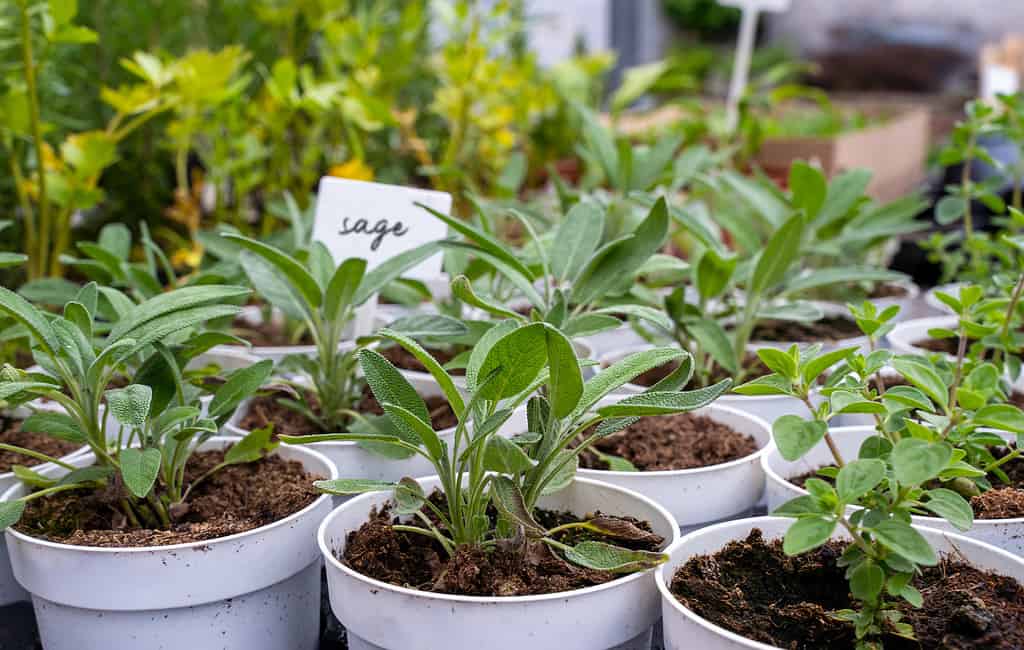
Grow sage with other aromatic herbs like rosemary to help repel flies.
©iStock.com/creativeneko
As yet another member of the mint family, sage contains similar oils that repel flies. One of those oils is camphor, a popular ingredient for insect-repellent sprays and lotions. So adding sage plants to your fly-repelling plan can boost your ability to ward off more than one type of insect pest.
However, burning sage leaves creates the most fly-repelling action with this plant. But burning sage as insect repellent requires safety precautions to avoid injury and damage to your home. And it’s important not to burn sage around children or pets due to possible toxicity from breathing in the smoke.
We suggest adding sage to a grouping of additional effective plants that repel flies, like rosemary. The aromatic oils in sage plants can still boost your home’s insect-repelling power without burning the leaves.
Is sage toxic for pets?
The ASPCA states that sage is non-toxic for dogs, cats, and horses. However, do not burn sage around pets because any kind of smoke inhalation could be harmful to their lungs and overall health.
7. Lemon Balm
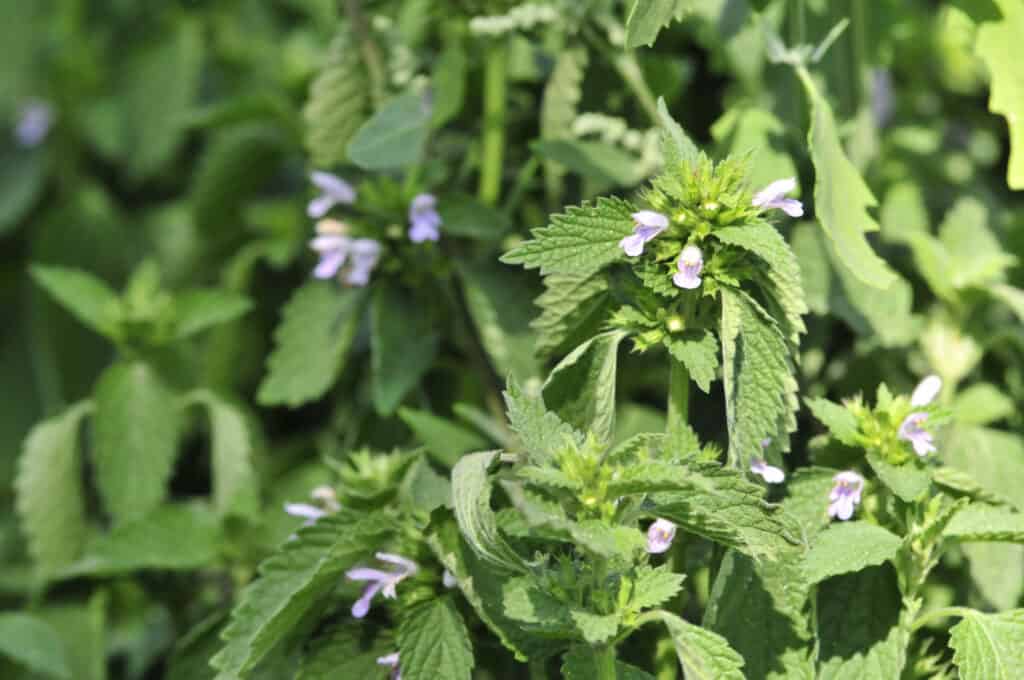
The lemon balm plant has a minty-lemon scent that flies hate.
©iStock.com/petrovaliliya
Another effective plant in the mint family that repels flies is lemon balm. It’s also an aromatic herbaceous plant, like lavender, containing fly-repelling natural oils linalool and geraniol.
Lemon balm is an ideal plant for people who love a minty-lemon scent. It’s a herb often used in soothing tea, and you can make a natural bug spray with lemon balm essential oil.
Is lemon balm toxic for pets?
Rest assured that lemon balm is non-toxic for cats and dogs. Though note that eating a large quantity of any herbs could cause stomach upset for pets.
8. Eucalyptus

The eucalyptus tree produces a compound called p-menthane-3,8-diol that repels flies.
©iStock.com/Marina Denisenko
You’ve probably seen dried flower arrangements that include eucalyptus, but you can also grow eucalyptus trees at home to repel flies with their scent. However, eucalyptus trees can grow way too big (5-200 feet tall) for indoor pots. So check garden suppliers for dwarf eucalyptus varieties better suited for planting under your roof.
For growing eucalyptus trees outdoors, consider the Eucalyptus citriodora, also called a lemon-scented gum tree. This tree is a popular species for its insect-repelling qualities. It also contains a compound that repels flies called p-menthane-3,8-diol, often used in pesticides.
Is eucalyptus toxic for pets?
Unfortunately, eucalyptus is toxic for dogs and other pets. Eucalyptus poisoning can cause diarrhea, difficulty swallowing, vomiting, seizures, and other symptoms.
9. Garlic
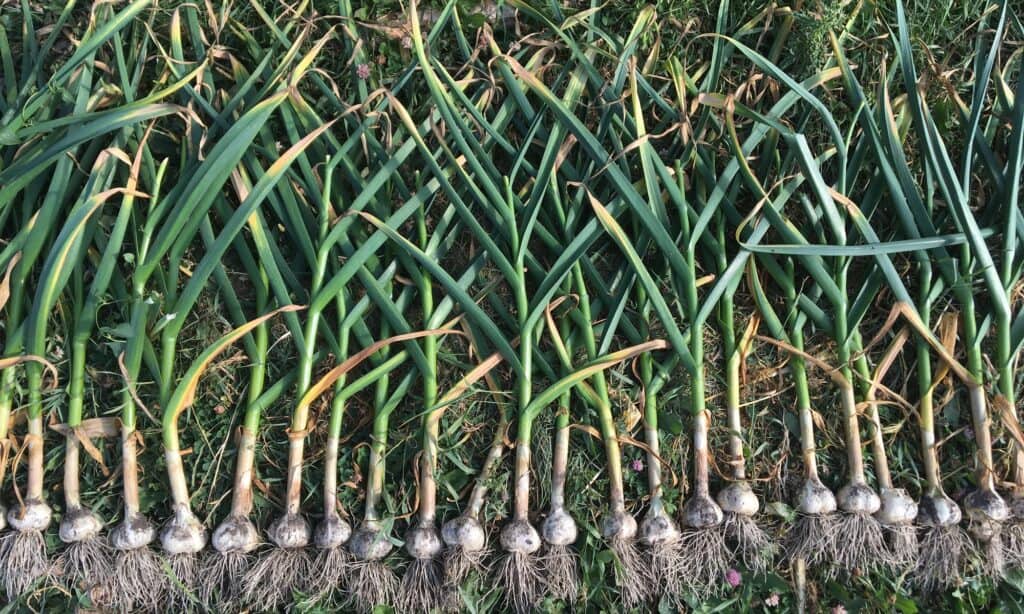
Crushing garlic cloves releases a fly-repelling compound called allicin.
©amandalala123/Shutterstock.com
You can thank the scent of allicin and other fragrant compounds in garlic for making this vegetable a strong fly-repelling plant. Allicin is released when garlic cloves are opened, which is why garlic smells more pungent when you cut or crush it.
So growing garlic plants around the house will help repel flies, but simply cooking with the garlic you grow will work even better. Flies hate the smell of garlic and won’t want to be anywhere near your fresh batch of homemade pesto!
Is garlic toxic for pets?
Garlic, onions, and other plants in the allium family are toxic for pets. So keep your dogs and cats away from garlic plants, bulbs, and any foods made with garlic.
10. Carnivorous Plants
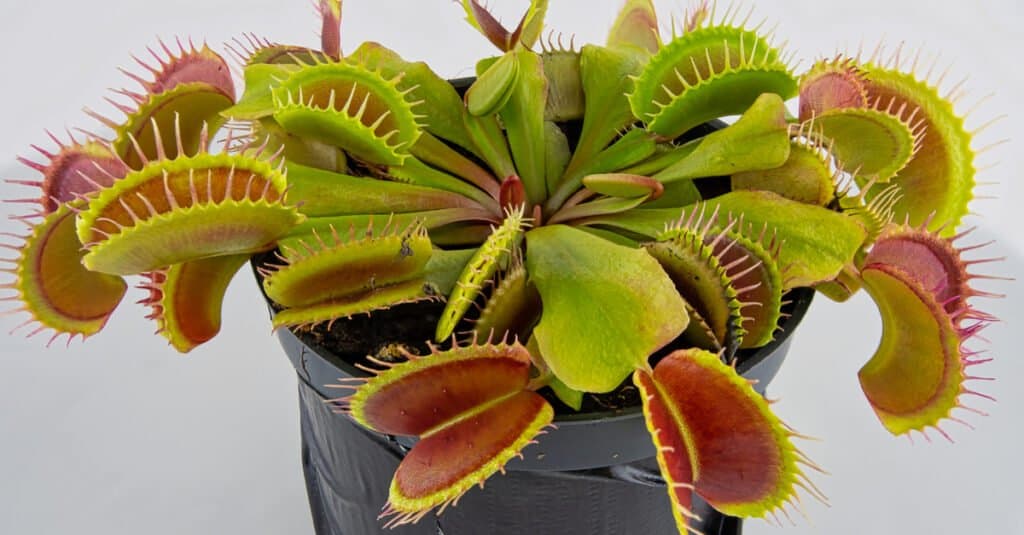
Venus flytrap plants trap flies to kill and then digest them.
©Craig Russell/Shutterstock.com
One way to repel flies is to grow plants that actually eat them. Carnivorous plants supplement nutrients from insects to survive and have built-in traps to catch bugs like flies, ants, beetles, and spiders. Flies are attracted to the smell of carnivorous plant nectar and become trapped when they dive in for a drink.
For example, a Venus flytrap plant has hinged leaves that snap shut when a bug lands between them. However, Venus flytraps might only need to eat one insect every few months, so you’d probably want more than one plant.
Pitcher plants are also carnivorous. They have slippery pitcher-shaped leaves full of liquid that drown the insects that fall in. Then the pitcher plant digests the drowned bugs.
Other types of carnivorous plants that are effective for repelling flies include:
- Sundews
- Monkey cups
- Bladderworts
- Butterworts
- Cobra plants
Are carnivorous plants toxic for pets?
Most carnivorous plants are non-toxic for pets. However, eating these plants could cause cats or dogs to feel nauseous and vomit.
There are many effective plants that repel flies
We think you’ll agree that summertime is much more enjoyable with fewer flies buzzing around your head. So growing any of the many effective plants that repel flies could be an important act of self-care.
Whether aromatic or carnivorous, most fly-repelling plants in our list should be easy to grow for beginners. You can also grow these plants indoors year-round to help keep your home pest-free and smelling great.
Summary of 10 Effective Plants That Repel Flies
| Number | Plant | Is it Toxic for Pets? |
|---|---|---|
| 1 | Lavender | Yes – in large quantities |
| 2 | Mint | Yes – causes diarrhea and vomiting |
| 3 | Basil | No |
| 4 | Rosemary | No |
| 5 | Catnip | No |
| 6 | Sage | No |
| 7 | Lemon Balm | No |
| 8 | Eucalyptus | Yes – can cause diarrhea, difficulty swallowing, vomiting, seizures, and other symptoms |
| 9 | Garlic | Yes – including food prepared with garlic |
| 10 | Carnivorous Plants | No – but can cause stomach upset |
The photo featured at the top of this post is © iStock.com/ASIFE
Thank you for reading! Have some feedback for us? Contact the AZ Animals editorial team.






